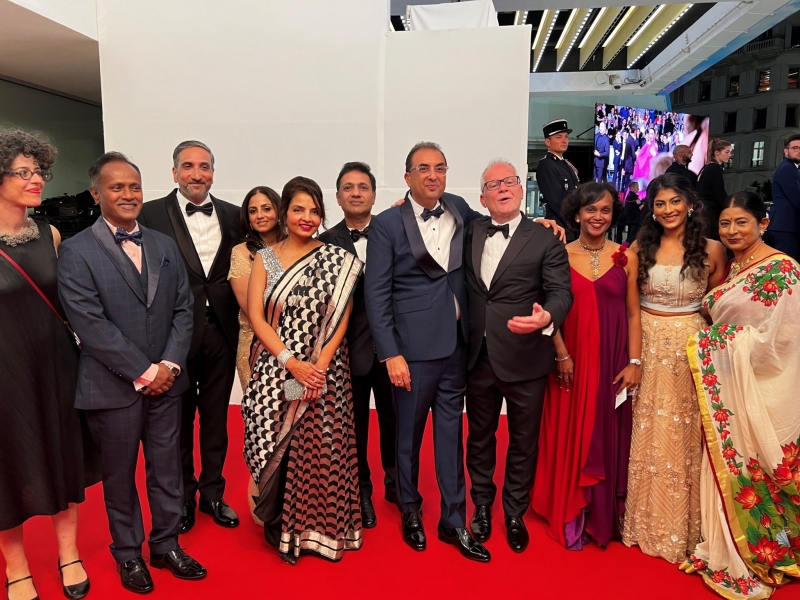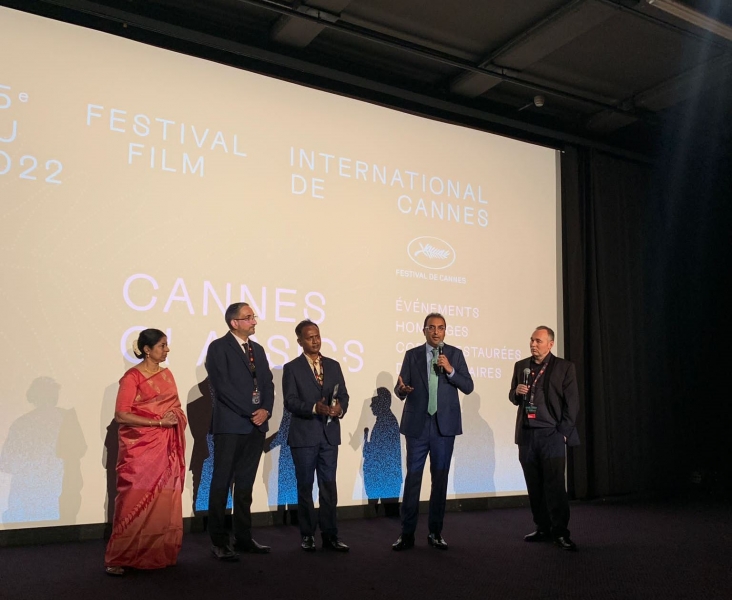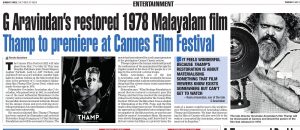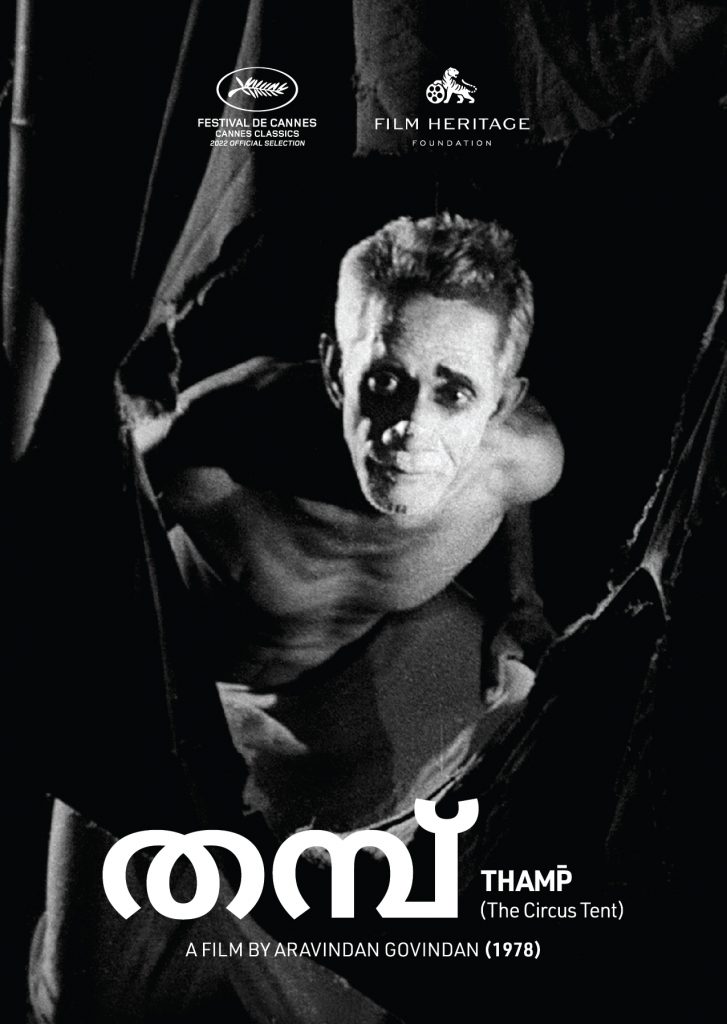
Film Heritage Foundation has joined hands with Prasad Corporation Pvt. Ltd. to restore the auteur Aravindan Govindan’s acclaimed film “Thamp̄” (1978) with The Film Foundation’s World Cinema Project and Cineteca di Bologna.
It is a matter of pride for Film Heritage Foundation that the restoration has been selected for a world premiere at the prestigious Cannes Classic section of the Cannes Film Festival 2022.
THE RESTORATION PROCESS – SHIVENDRA SINGH DUNGARPUR, DIRECTOR, FILM HERITAGE FOUNDATION
The restoration of Thamp was a challenging process that took almost eight months of painstaking work. The first step in the journey was when I travelled to Kollam in Kerala on February 1, 2020 to meet the producer, K. Ravindranathan Nair of General Pictures. A businessman with a successful cashew export business, Mr. Nair was certainly not your usual producer. I was keen to meet the man who had played such a significant role in the evolution of Malayalam New Wave cinema producing landmark films like Adoor Gopalakrishnan’s “Elippathayam” (1981) and “Anantaram” (1987) or Aravindan’s “Kanchana Sita” (1977), “Thampu” (1978) and “Kummatty” (1979) to name a few under the banner of General Pictures. I spoke to him about our desire to do a 4K restoration of two of Aravindan’s films “Kummatty” and “Thampu”. A man of few words, he readily gave his permission to restore the films.
We were aware that the National Film Archive of India (NFAI) had film elements of “Thamp̄” in its collection, but we needed to ascertain exactly what they had and assess the condition of the material. Film Heritage Foundation, as a member of the International Federation of Film Archives (FIAF), also put out a call to all the 171 member institutions around the world to check if they had film elements of “Thamp̄” in the hope that we might still discover good condition prints or dupe negatives in some part of the world. However, the only response we got was from the Fukuoka Archive in Japan that had prints with Japanese subtitles burned into the print, which made the material unusable for a restoration.
We then got in touch with the NFAI and our film conservators travelled to Pune to do a condition assessment of the Thamp̄ film elements in their collection. While there was no original camera negative, which would have been the best source element, we found that we could use a dupe negative struck from a 35mm print that was at the NFAI. A second 35 mm print could be used for comparison. As per the condition assessment report prepared by the Film Heritage Foundation conservators, there were tears and broken sprockets in the films which were repaired by our conservators. The other challenge was that as the dupe negative was struck from a print, it did not have as much latitude as an original camera negative would have had. We first did a test scan of both the print and the dupe negative. Having worked with both Prasad Studio in Chennai and L’Immagine Ritrovata, Bologna in the past, we decided that we would split the restoration process between the two labs and requested Davide Pozzi, Director of L’Immagine Ritrovata, one of the best restoration labs in the world, to supervise the restoration
We spoke to Saiprasad Akkeneni of the Prasad Corporation Pvt. Ltd. in Chennai, who agreed to partner with us on the restoration by doing the scanning and digital clean-up of the film at their facilities in Chennai. As a good quality scan is the basis of a world-class restoration, Davide Pozzi set the parameters of the scan and agreed to oversee the process. The scanning of the picture and sound and the hours of manual work that went into the digital clean-up of the scratches and tears and the image stabilization was done at Prasad Studios in Chennai. The restoration workflow was a process that needed constant coordination between our Director Shivendra Singh Dungarpur in Mumbai, the Prasad technicians in Chennai and the lab in Bologna.
FILM REPAIR STILL
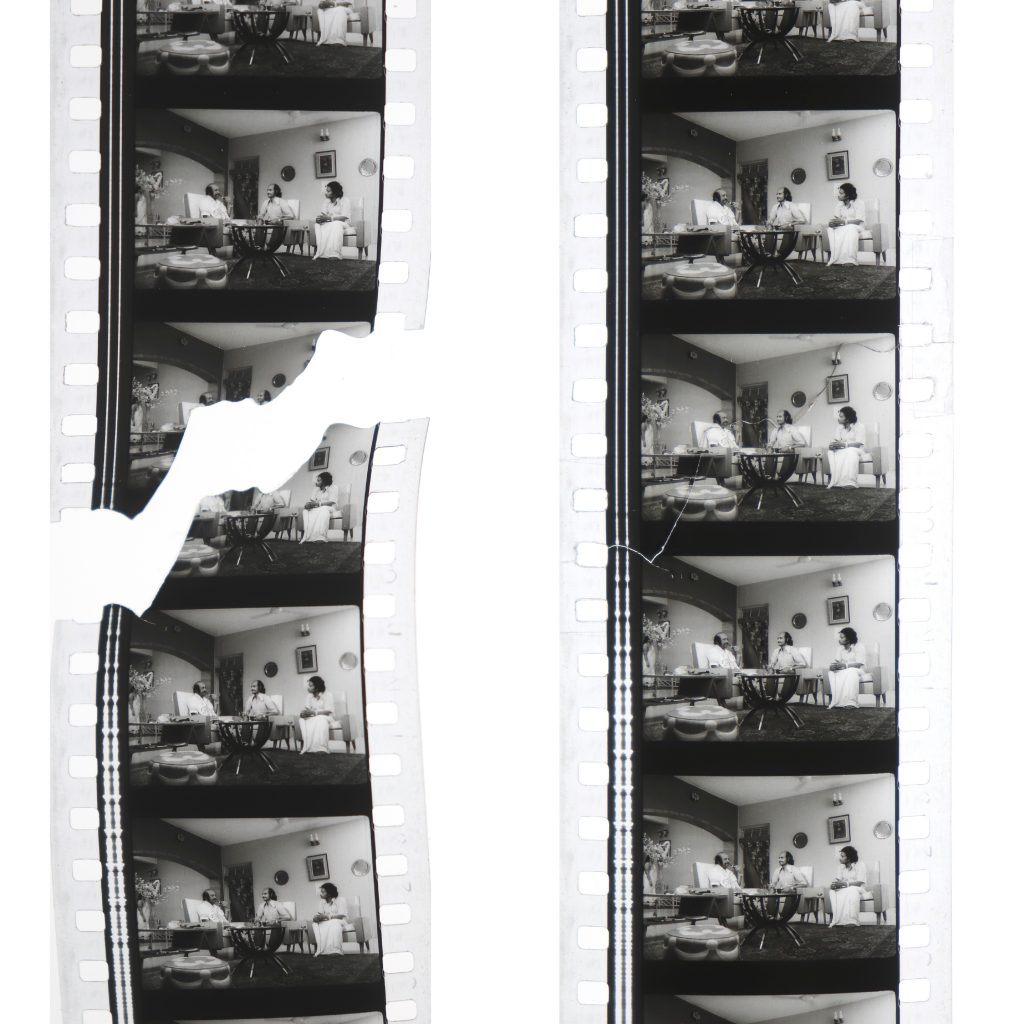
RESTORATION STILLS – BEFORE AND AFTER
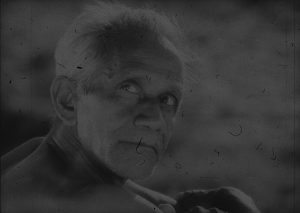
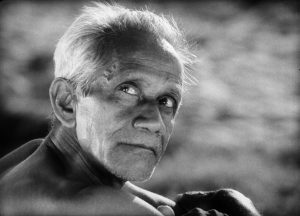
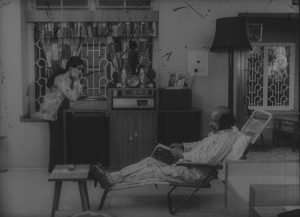
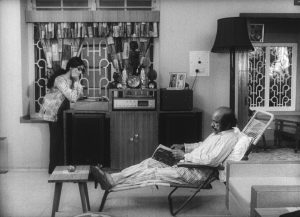
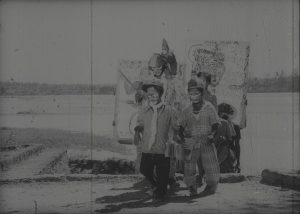
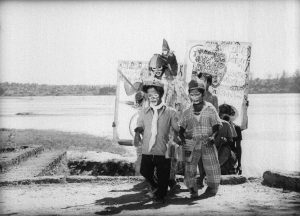
We involved Ramu Aravindan, photographer and graphic designer, and the son of Aravindan, every step of the way, to give us inputs on his father’s vision of the film. We also spoke to eminent filmmaker and cinematographer, Shaji N. Karun, who shot the film, who told us that the film had been shot on Indu stock (an indigenous film stock manufactured in India) and about the lighting scheme and compositions of the stunning black and white imagery of the film. The colour grading, which was personally supervised by Shaji N. Karun and Ramu Aravindan, and sound restoration of the film was done at L’Immagine Ritrovata, Bologna.
We are hoping that by showcasing the Thamp̄ restoration at Cannes, it will give new life to the work of a true artist like Aravindan whose work must not be forgotten.
RESTORATION CREDITS
“Restored by Film Heritage Foundation, The Film Foundation’s World Cinema Project, Fondazione Cineteca di Bologna at Prasad Corporation Pvt. Ltd’s Post – Studios, Chennai and L’Immagine Ritrovata Laboratory, and in association with Producer K. Ravindranathan Nair of General Pictures and the family of Aravindan Govindan.”
Thamp̄ was restored using the best surviving element: a Dupe Negative struck from a 35mm print preserved at the National Film Archive of India. A second 35mm print with English subtitles was used as a reference.
Funding supported by Prasad Corporation Pvt. Ltd. and Film Heritage Foundation.
CAST AND CREW DETAILS
Thamp̄ (The Circus Tent), India, 1978, Aravindan Govindan
129 minutes, B&W, Malayalam, English Subtitles, Aspect Ratio 1.37
Script: Aravindan Govindan, Cinematographer: Shaji N. Karun, Sound: Devadas, Editor: A. Ramesan, Music: Kavalam Narayana Panicker and M.G. Radhakrishnan, Production House: General Pictures, Kollam, Producer: K. Ravindranathan Nair
Cast: Bharath Gopi, Nedumudi Venu, D. P. Nair, Sreedharan Chambad, Jalaja, Murikkoli Krishnan, Shreeraman, Kottara Gopalakrishnan, Njeralath Rama Poduval, Artistes of the Great Chitra Circus, Residents of Thirunavaya village on the river Bharathapuzha.
ABOUT THAMP̄ (THE CIRCUS TENT) (1978)
Aravindan Govindan’s Thamp̄ is a poetic, allegorical film, that gently explores the transience of human relationships and the rootlessness of the marginalized through the ripples created in the bucolic existence of a village on the banks of a river by the arrival of a roving circus troupe. In cinéma-vérité style, Aravindan rounded up a troupe of actual circus artistes and travelled with them to the village of Thirunavaya on the banks of the Bharathapuzha river. On the first day, the circus was set up and all the villagers were invited to watch the show. Aravindan said in an interview, “We did not have a script and we shot the incidents as they happened. . . There were a lot of people who had not seen a circus before. We shot their responses as they were watching. After the initial hesitation, they forgot the lights and the shooting and got completely involved in the circus.” For three days, the circus is the centre of attention of village life, but soon the villagers lose interest and move on to the preparation for a local festival and the circus troupe packs up and trundles away leaving no trace. Alienated from his own milieu, a young man from the village clambers on to the departing truck, hoping to escape his discontent by joining the circus troupe in their drifting existence. The beauty of the film lies in the reflective silences, the deeply observational, but delicate gaze of the camera, juxtaposing the pathos of the circus performers as they go about their everyday tasks and more starkly in impassive close-ups as they speak directly to the camera, against the innocent wonderment of the captivated village audience, in black and white imagery that stays with you long after the big tent has folded up.
ABOUT ARAVINDAN GOVINDAN
Aravindan Govindan was one of India’s most extraordinary filmmakers and a leading light of the New Indian Malayalam cinema of the 1970s and ‘80s. A true Renaissance man – he was a painter, cartoonist, musician, theatre director, and filmmaker. An autodidact, his films were free from the weight of film canon, marked by an entirely original approach to cinema. In a tragically short career spanning from 1974 to 1991, he made 11 films and 10 documentaries with almost all of his films receiving national or state awards.
From his first film “Uttarayanam” (1975) to his last “Vasthuhara” in 1991, his remarkable filmography included cinematic gems like “Kanchana Sita” (1977); “Thamp̄” (1978); “Kummatty” (1979); “Pokkuveyil” (1982); “Chidambaram” (1985) and “Oridathu” (1987).
He has been described as a poet-philosopher with a vision, who made mystical, transcendental films that showed deep compassion for the eccentric, the marginalized, and the alienated. In the words of Aravindan – “Cinema, like painting or music, is best when it is pure and serves an aesthetic function.” And each of his works is a testimony to the purity of his philosophy as an artist.
Director Stills: Director Aravindan Govindan with Cinematographer Shaji N. Karun on the sets of the film Thamp̄
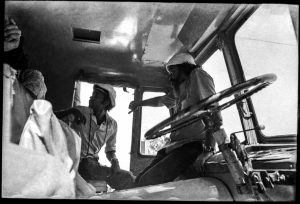
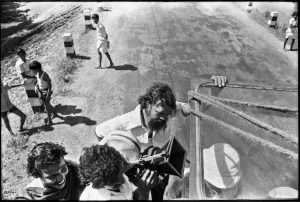
Photo courtesy – N. L. Balakrishnan Archive at Film Heritage Foundation
PICTURE GALLERY:
NEWS ARTICLES:
(Click on image to read the full article)




